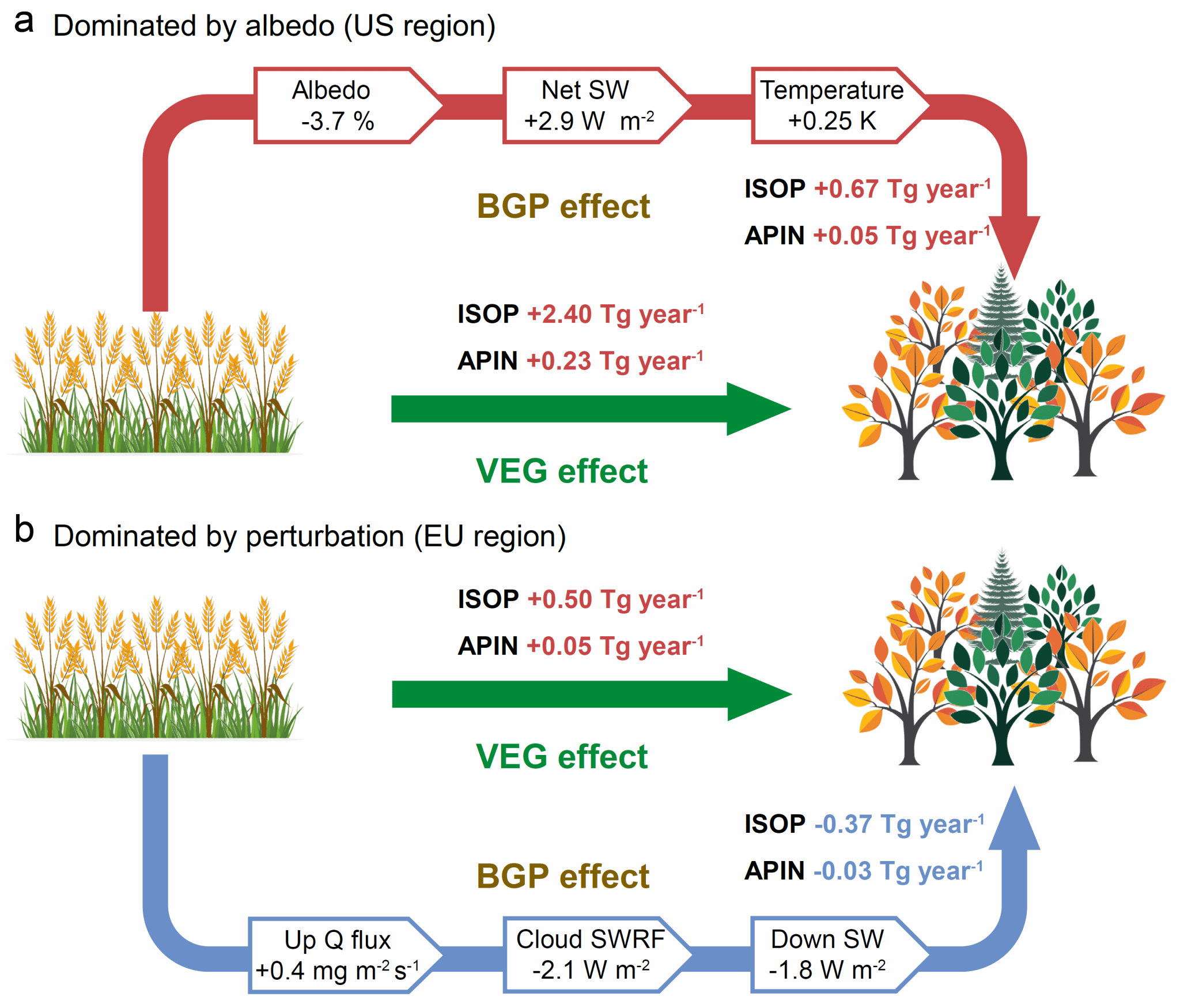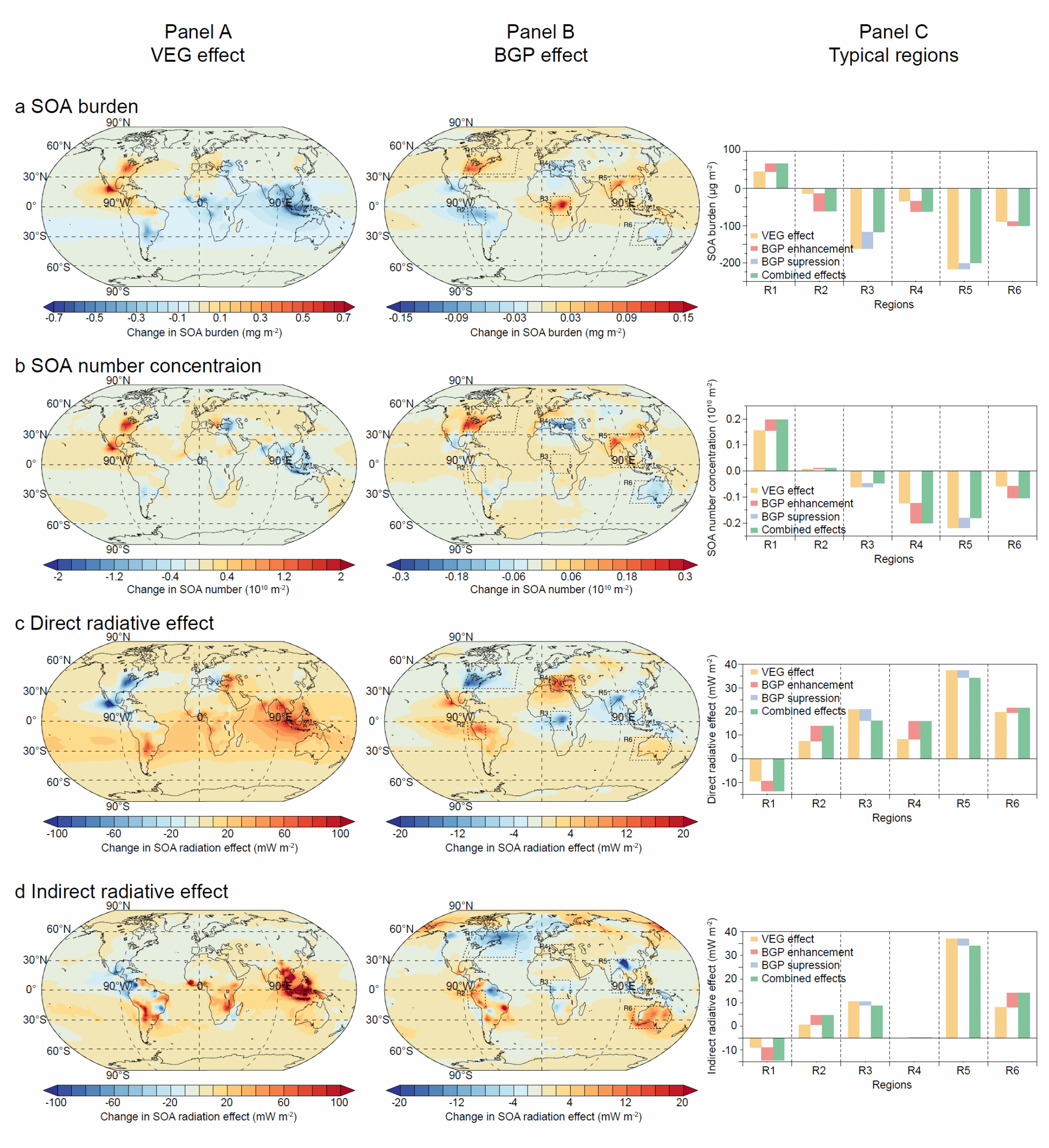A groundbreaking study published in National Science Review demonstrates that forests exert bidirectional control over biogenic secondary organic aerosol (BSOA) cooling effects through biogeophysical processes—with outcomes critically dependent on local climate conditions. In regions dominated by dark canopies, reforestation typically enhances cooling by warming surfaces and stimulating natural aerosol formation. Conversely, where forests strengthen atmospheric updrafts and cloud formation, they often suppress cooling by reducing sunlight and biogenic emissions. This newly discovered "climate lever" creates striking regional contrasts, proving that identical forest cover can yield opposite aerosol-mediated climate outcomes. The findings underscore the need for location-specific reforestation strategies to optimize climate benefits.
Research team led by Professor Pingqing Fu has revealed previously overlooked complexities in vegetation-climate interactions through advanced Earth system modeling. Their work demonstrates how forest cover changes affect climate via intricate aerosol formation processes, showing that reforestation efforts must account for regional atmospheric feedback variations to achieve optimal climate benefits. While widely touted as a climate solution, this study proves tree planting's mechanisms are significantly more complex than traditionally assumed.
While reforestation and afforestation are established strategies for climate change mitigation, their benefits extend far beyond carbon sequestration. A comprehensive assessment must consider vegetation's dual climatic impacts through surface-atmosphere interactions: altered surface albedo modifies Earth's radiative balance, while structural changes in plant cover disrupt near-surface airflow dynamics. These biogeophysical processes initiate complex climate feedbacks. Concurrently, vegetation-emitted BVOCs oxidize to form BSOA - atmospheric particles that cool climate systems through solar radiation scattering and cloud microphysical regulation.
The study uncovers a dual regulatory mechanism mediated by contrasting biogeophysical pathways: In albedo-driven scenarios, expanded forest cover reduces surface reflectivity, increasing solar absorption and localized warming. This thermal enhancement stimulates greater BVOC emissions from vegetation, thereby amplifying BSOA-mediated radiative cooling. Conversely, in aerodynamically-dominated regimes, forest-induced updrafts intensify moisture transport, fostering extensive cloud development. These cloud layers attenuate surface-level solar radiation, ultimately suppressing both BVOC emissions and subsequent BSOA formation - weakening the overall cooling capacity.
This bidirectional regulation originates from fundamental regional variations in biogeophysical dominance: where albedo reduction serves as a "warming engine" to boost BSOA cooling, aerodynamic effects conversely operate as a "sunshade" to suppress it. These opposing mechanisms underscore the intricate surface-atmosphere interactions that ultimately govern afforestation's net climatic influence.

Figure 1. Differential mechanisms of biogeophysical effects in afforestation on BVOCs emissions.
Earth system modeling uncovers significant spatial variability in how biogeophysical processes influence BSOA radiative effects across global vegetated regions. The simulations demonstrate a striking dichotomy: in approximately half of vegetated areas, biogeophysical feedback acts as a powerful "effect amplifier," potentially doubling BSOA radiative impacts, while in the remaining regions, these same processes serve as efficient "dampening regulators," neutralizing more than 50% of BSOA-induced radiative changes. This pronounced contrast highlights the critical importance of regional considerations when evaluating afforestation's climate impacts.
The research highlights a critical nonlinear relationship between vegetation changes and atmospheric impacts: even modest alterations in forest cover can trigger disproportionately strong biogeophysical feedbacks, dramatically amplifying BVOC emission variability. This effect is particularly pronounced in dense, high-biomass ecosystems such as the Amazon, where complex vegetation-atmosphere interactions dominate regional climate systems. Crucially, the study warns that current climate models neglecting these spatially heterogeneous feedback mechanisms may substantially misrepresent BSOA's radiative forcing potential in future afforestation scenarios, potentially leading to flawed climate mitigation projections.

Figure 2. Projections of global and regional secondary organic aerosols and their radiative effects under future vegetation change scenarios
This groundbreaking study provides the first systematic revelation of the dual regulatory mechanism through which vegetation-induced biogeophysical effects modulate the radiative forcing of biogenic secondary organic aerosols (BSOA). By deciphering the global spatial heterogeneity of biogeophysical-aerosol interactions, the research proposes region-specific afforestation strategies. These findings establish a scientific foundation for synergistically optimizing carbon sequestration benefits with aerosol-mediated climate effects, enabling precision enhancement of ecological engineering programs' net climate benefits.
The first author of this study is Professor Zhu Jialei from Tianjin University, and the corresponding author is Professor Fu Pingqing from Tianjin University. The research was conducted under the guidance of Academician Liu Congqiang from Tianjin University and Professor Joyce Penner from the University of Michigan, USA. Collaborators include Professor Zhao Xi, Associate Professor Deng Junjun, PhD candidate Liu Hao, PhD candidate Guo Qinghao, and PhD candidate Liu Yaxin, all from Tianjin University. This study was supported by the Innovative Research Group Project of the National Natural Science Foundation of China (Grant No. 42221001).
Jialei Zhu, Joyce E. Penner, Hao Liu, Qinghao Guo, Yaxin Liu, Junjun Deng, Xi Zhao, Cong-Qiang Liu, Pingqing Fu*, Reforestation-induced aerosol cooling effects divergently modulated by various biogeophysical feedbacks. National Science Review, https://doi.org/10.1093/nsr/nwaf323.